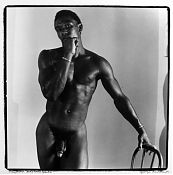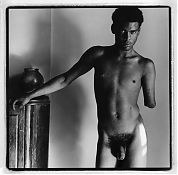June 21, 2012
George Dureau: ‘Black 1973-1986’
By ROBERTA SMITH
Higher Pictures
980 Madison Avenue, at 76th Street
Through July 13
The first New York exhibition of George Dureau’s black-and-white photographs, mostly of bare-chested or nude young men, is long overdue. Mr. Dureau, who was born in New Orleans in 1930 and has lived most of his life there, began taking them in the early 1970s. The photographs were partly intended as studies for his figurative paintings, which they tend to overshadow.
They have long been known for their undeniable, often homoerotic sensuality and for emphasizing the persistence of male beauty regardless of race or physical imperfection: many of the subjects are black; some are dwarfs or amputees.
The 15 prints on view here concentrate exclusively on young black men, among them Short Sonny, a dwarf who sometimes favors turbans, and Alphonse Dotson, a former tackle for the Oakland Raiders, whose powerful upper torso and head are seen from the side as he looks slightly upward, open yet somehow resolute.
Viewers who are reminded of work by Robert Mapplethorpe should be aware that Mapplethorpe saw Mr. Dureau’s work before he began taking his own astutely idealized, sometimes starkly erotic images of black men.
Also hard to miss is that Mr. Dureau’s subjects have an individuality, vulnerability and intensely personal gravity that Mapplethorpe’s more objectified models often lack.
This difference has been pinpointed as “foremost a matter of empathy” by the literary scholar Claude J. Summers, who is quoted in the gallery’s news release.
It might be added that, as seen here, Mr. Dureau’s photographs share an emotional realism and a sense of intimacy between artist and sitter of the kind that also enriches the portrait paintings of Alice Neel.
They are wonderfully immediate and alive.
This article has been revised to reflect the following correction:

